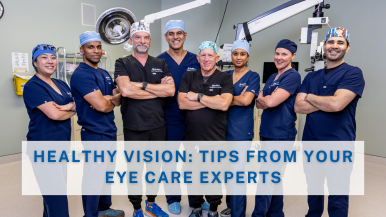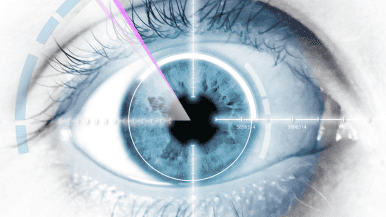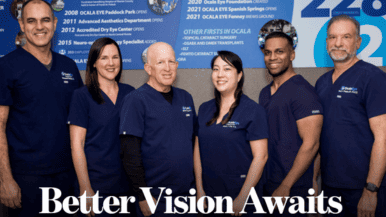- What is a cataract?
- Why would I need cataract surgery?
- What happens during cataract surgery?
- What are the unexpected benefits of cataract surgery?
Vickie H. has been a patient of Hina N. Ahmed, M.D., board certified ophthalmologist specializing in cataract surgery at Ocala Eye for the past four years. Still, Vickie says, “When she told me I needed cataract surgery, I was a bit apprehensive.”
Cataracts, which cloud the lens of the eye, are fairly common in the aging population. By age 75, you have around a 50% chance of developing one. Surgery is the best course of treatment for cataracts, and for Vickie, the recovery from the surgery was smooth and standard, and she continues to be amazed at how well she sees today.
What Is a Cataract?
Your eyes are complex organs made up of several delicate parts. As you age, so do your eyes, and one of the common disorders you might experience is vision that gradually begins to dim. This makes it hard to drive at night, read, or, even conduct basic activities like watch TV or see your cell phone. The cause behind the reduced vision is often cataracts, which are very common after the age of 40.
A cataract is simply a clouded lens at the front of the eye. It happens when the proteins produced in your eyes begin to clump and collect against the lens. This is what causes the blurriness and gradual decline of your vision.
The lens of your eye is normally colorless and clear, which allows light to shoot into the eye toward the retina at the back where your brain processes the image. Problems arise as the cloudiness grows and the light can’t enter the eye properly. When a cataract causes the outer lens to become dull and opaque, it appears as a white cloudiness when you look into the eye.
Why Would I Need Cataract Surgery?
Cataract surgery replaces a cloudy lens of the eye with a new, clear lens. Surgery is the only way to eliminate cataracts, and without it, you could be at risk for eventual blindness, as your vision becomes increasingly blocked by the clouded lens.
Think of cataracts like the lens of your car’s headlights. When you first buy the car, the headlights are pristine and new. Weather and the elements over time cause the headlights to turn dingy, yellowish, and foggy. The same thing can happen to your eyes. The best news is that your headlights can be restored to their original clear state with a little baking soda and a toothbrush. For your eyes, cataract surgery can remove the clouded lens and replace it with a brand new clear one.
Vickie experienced successful cataract surgery with the team at Ocala Eye. Any surgery can be a concern, but Vickie says, “After Dr. Ahmed explained the procedure and the surgery to me, I decided to go ahead and have it done. I’m so happy that I did.”
What Happens During Cataract Surgery?
There are several steps to cataract surgery, which takes less than an hour and can be performed in an outpatient setting:
- The doctor will place numbing and dilation drops in the eye
- You may be given a sedative to help you relax and receive local anesthetics to numb the area
- The doctor will use a tool to hold your eye open and will remove the clouded lens
- The doctor will insert an artificial clear lens, called an intraocular lens (IOL) that is designed specifically for your eye
- You will be free to go home the same day, not even requiring stitches
After the procedure, you will notice your vision improving rapidly over the next 48 hours. You will also have frequent checks with your doctor to ensure that the eye is healing properly. Your doctor may have you wear an eye patch to keep the eye protected and prescribe eye drops and medication to prevent infection. Complete healing takes about eight weeks. If both eyes have cataracts, the doctor will do surgery on the first one, then wait a few weeks to repeat the procedure on the second eye.
Vickie describes her procedure as “relatively pain-free.” She came through her cataract surgery with flying colors, saying the staff at Ocala Eye were “absolutely wonderful.” Interestingly, Vickie finds herself enjoying an unexpected side effect of the surgery: “I can now see as well as I did when I was in my twenties,” she says. “There are no more glasses for me.”
What Are the Unexpected Benefits of Cataract Surgery?
Being able to see better than you have in years is a typical side effect of cataract surgery. That’s because your doctor will take very precise measurements for the placement of the IOL in your eye. There are many types of IOLs available that can correct vision in addition to giving you a clear lens to see through.
Having a brand-new refractive-corrective lens placed perfectly in the eyes may allow your vision to improve. It is very possible to correct refractive errors during this process, just like was done for Vickie. However, this isn’t always the case; every patient’s experience is unique. About one-half of cataract surgery patients may continue requiring corrective lenses.
Cataract surgery has additional benefits that might surprise you, such as better night vision. If you have cataracts, you may experience more glare from street or car lights. Clearer lenses without cataracts can eliminate this problem. Brighter, crisper colors are also a benefit of cataract surgery, as cataract clouding can also make you see the world with a yellowish tint.
Vickie is just one of the patients this year that benefited from cataract surgery with Ocala Eye. “They’re very professional, very efficient, and very forward in their treatment of patients,” she says. “I would highly recommend Ocala Eye.”




